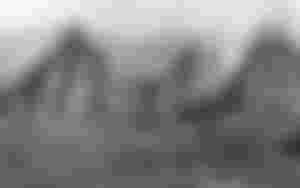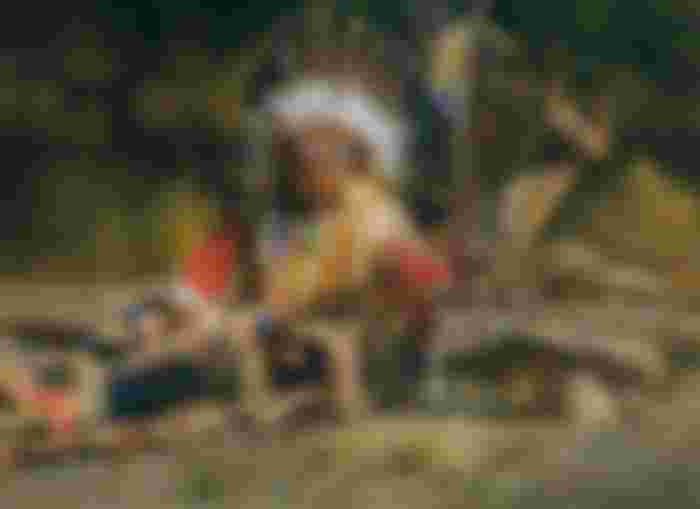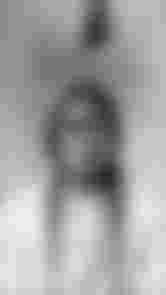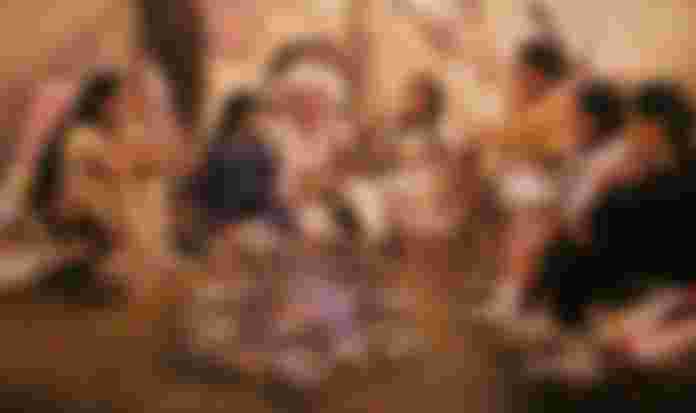SIOUX
A North American tribe inhabiting the area between the Mississippi and Missouri rivers. The earliest known ancestral home of the Sioux is the marshy area of rice lakes, in present-day Minnesota. This area is known for being inhabited by the very warlike Chippewa tribe (the Chipiva tribe, from which the original name of the legendary Mississippi-Mici Zibi or Great River originates). Chipivas called their eternal enemies the Nadowessi (Little Snakes). The Sioux were a confederation of 7 tribes. The struggle for supremacy over the rice fields between Chipiva and the Sioux led to the persecution of the Sioux from those parts. In 1876, with the help of the Allies, they defeated the American army and General Custer on the Little Big Horn River. It was preceded by a lesser-known battle at Devils Tower. There was a very fierce resistance prepared by less mobile old men who could not keep up with the pace of the tribe. The Sioux massacre by the US military took place in December 1890 near Wounded Knee Creek, South Dakota - it was the final end of their courageous resistance to great evil, a force that would try to subdue the rest of the world with its "merciful democratic" principles a century later. Today, the Sioux still "exists" only in the reserves in Minnesota, North and South Dakota, Montana and Nebraska.
The Sioux are a typical hunting prairie tribe. They lived in leather tents called tepee, which are easy to fold, unfold and carry. Bison were their main source of food and other needs. The horse was also a symbol of their culture and meant wealth and power of the owner. As for religion and ritual, they relied on the power and influence of shamans. Shamans (priests, spiritual leaders and doctors in the tribe) played an important role in defending the tribe from dark forces and evil spirits. With their mystical and ecstatic dance, they plunged into the depths of the soul and brought to light the spiritual strength, truth and answers to many questions and needs of a man thrown into the chaos of transience and existential anguish...

Famous Sioux chiefs (who bravely said NO)
SITTING BULL (1834-1890)
The legendary chief of the Dakota Sioux tribe, a warrior who opposed the relocation of his people to the reserves, which led to the Battle of Little Big Horn in 1876, in which American General Custer was killed and in which the American army was defeated. He gained warrior fame in the battles with the Crow Indians, and then in the resistance to the penetration of whites into the territory of the Great Plain in the 1960s and 1970s. Although he defeated Custer, he had to flee to Canada, where he remained until 1881, when he was amnestied by the American government. Until the end of his life in 1890, he continued to fight against white immigrants and murderers. The center of his resistance was the Indian faith "Dance of the Spirits", which promised the arrival of an Indian messiah who would return the land to the Indians, which fueled new revolts. He was killed in one of the riots, while resisting arrest.
CRAZY HORSE (1842-1877)
The head of the Sioux Indians of the Oglala tribe, who opposed the intrusion of whites (as the Native Americans called them) into the mineral-rich Black Hills, and who also took part in the Indian victory over the American army at Little Big Horn, 1876 . years. The most famous Indian military leader, fear and trembling among the American army. He was a skilled warrior, a guerrilla who often managed with wisdom and cunning to drag American troops into ravines and traps across wild America…
After the first military confrontation between the Sioux and white uninvited guests in 1854, the Crazy Horse opposed plans to place the Indians in reserves and led an alliance that defeated General George Crook at the Rosebad River and, later, George Custer. Together with his followers, he was brought to surrender by starvation in May 1877. He was later captured due to rumors that he was planning a rebellion. He was stabbed to death, allegedly while trying to escape…
COLORFUL TAIL (1823-1881)
The head of the Sioux, one of those wise enough Indians to understand in time what future the white man intended for them… He was an orphan raised by his grandparents. He was left without them very early and took care of himself. He developed courage, wisdom and ingenuity, became a good shooter and a skilled hunter, fighting from an early age for his place in Indian society. A superior mind, learning trade and economics by observing whites, over time he remained a skilled merchant… He also soon distinguished himself as a very skilled and brave warrior - in the battle against Utah, a numerically superior enemy, he showed courage and resourcefulness, receiving recognition from the great chief of the Winning Bear.

Chief LITTLE CROW (1810-1863)
He was the son of Ketanvakuv ("Falcon Attacking"). Because of the bad translation of his father's name, the whites called him Little Crow. His name was Taojateduta - A member of the Red People. He was an extremely ambitious and fearless man, the leader of the Sioux in a very difficult, crucial time. He was one of the best hunters of his tribe. Although he became a chief as a young man, he had a very rich war experience in the period of dramatic changes for the Indians, in the middle of the 19th century. It was a time of humiliating and false treaties by the United States, a time of Indian land grabbing, expulsions and massacres.
Chief Little Crow was one of those leaders who tried to save their people from the coming evil and disappearance through diplomacy. However, as agreements with whites were often a pure farce, to the detriment of the Indians, he decided to lead his people (during the American Civil War of 1861-1865) into a war against quarreling whites. Unfortunately, the fight turned out to be in vain - Little Crow decides on a desperate act of concluding a truce, a pact with the executioner, and on that occasion he dies from a bullet fired from his own rifle by accident. It was one of the final acts of the end of the dreams of one great man and people of the Great Spirit. Their country has been overrun and scorched by the evil that will rule the whole world for decades to come.

Chief Makhpiya (Red Cloud) is one of the most successful Indian military leaders, a warrior who led more than 2,000 Arabs, Sioux and Cheyenne. After two years of war, he forced the American army to withdraw from the Lakota territory (today's Wyoming and Montana). Authorities begged the Red Cloud for a truce with a promise to withdraw and never return to Indian territories. Of course, it was a pure insidious lie and deception, and the whites skillfully used it to regroup, to return. "When the white man came to my country, he left a bloody trail behind."
MANDAN (Numakaki):
The Siouan Indian tribe, originally inhabited along the Hart River, a tributary of the Missouri, and then along the Knife River. An encounter with whites almost killed them in the middle of an epidemic of smallpox, around 1837. Weakened and on the verge of extinction, they joined the Hidatsa tribes in 1845 and went to the Fort Berthold Reserve, where their descendants still live today. The Mandans are rural, but true prairie Indians, bison hunters. They lived in large earthen houses, in settlements protected by palisades. They grew corn and held multi-day ceremonies called Okipa or O-kee-pa, in order to encourage bison fertility and and better yields. It was a summer festival. In winter, they held Snow owl, Red stick and White buffalo cow ceremonies.
Shoshone
The Shoshone form a large group of tribes of a language group called Central Numic in an area known as the Great Basin that includes parts of Nevada, Utah, Idaho, Wyoming, California, and West Texas. The main groups of Shoshone are Western, Northern and Wind River, which are further divided into a number of small groups. A large part of the Great Basin is a dry desert, unsuitable for life. Pine forests are only in the mountains, near lakes and streams. The climate is dry and hot in summer, while winters are extremely cold. The whole pool is surrounded by mountains. There are very few food sources. Their homes were windshields made of twigs, during the summer, and conical huts, in the winter.
PONY (Pawnee)
Caddoan Indian tribe language group and Plains culture from the Nebraska region. They lived in earthen huts crammed into small settlements. They were intensively engaged in agriculture. Their religion involved dealing with visions and ceremonial rituals. Their myths and folklore are rich in symbolism. During the 19th century, they were mowed down by diseases and attacks by the mortal enemies of the Sioux. Today, there are about 3,000 of them in the Nebraska and Oklahoma reserves.
ARAPAHO
An Indian tribe, an Algonquian language group, originally from the Minnesota area and later between the Yellowstone and Rio Grande rivers. They were a nomadic tribe and practiced a religious ceremony known as the "Sun Dance".
California Cultural Region - Intermountain Area
A cultural region that included the mountain ranges and valleys of Utah, Nevada and California, rich in pine forests, swamps and green valleys. At the time of the first settlers, it was a suitable area for hunting deer, chamois, birds and collecting wild fruits, as well as fishing. And later, he had good conditions for the survival of numerous tribes in this area, primarily thanks to the Pacific coast and fishing for large marine mammals. The tribes of this region are: Northern Paiute, Tolowa, Karok, Yurok, Shasta, Wiyot, Hupa, Achoviawi, Wiatua, Atsugewi, Bannock, Northern Shoshone, Chimariko, Yana, Washoe, Nomlaki, Yahi, Western Shoshone, Yuki, Maidu, Pomo, Konkow, Gosiute, Ute, Paiute, Wapoo, Miwok, Kawaiisu, Patwin, Mono, Panamint, Costano, Yokut, Chemehuevi, Esselen, Tubatulabal, Salina, Kitanemuk, Serrano, Chumash, Fernandeno, Gabrielino, Juaneno, Cahuilla, Luiseno Diegueno, Kamia, Akwa'ala, Nakipa, Kiliwa, Cochimi, Ignacieno, Waicura and Perica.
POMO
Pomo is the collective name of a tribe from California, which uses the languages of the Kulanapan family. They are divided into many tribes inhabited by small reserves of the Pacific coast. They were engaged in collecting fruits, fishing and hunting, using a bow and arrow… They are widely known for their ability to make baskets from shrubs, most often willow. Today, there are just over 2,000 left.

UTE
Uto-Aztecan Indian tribe language group. They lived in central and western Colorado, eastern Utah, and northwestern New Mexico. They lived from hunting and wild fruits and roots. They exchanged their handicrafts with the Navajo tribe and the Paiute tribe. They lived in shelters and later in tepee tents. After meeting the "real" Americans, they were moved to the reserves. Today, there are about 7,200 left and they "live" in the reserves of Colorado, New Mexico and Utah.
The Plateau - cultural region Plateau
It covers the mountainous region of Idaho, eastern Oregon, Washington and western Montana, covered with coniferous forests and green valleys. The northwestern United States was a convenient area for hunting deer, small game, and harvesting fruits, wild plants, and fruits. Also, it was an area that allowed fishing on the Colorado, Snake and Fraser rivers… The tribes that wandered there and lived freely until the arrival of savages are: Lillooet, Shuswap, Ntlakyapamuk, Nicola, Lake, Okanogan, Methow, Wenatchee, sanpoil, Chelan, Columbia, Kootenay, Colville, Pend d 'Oreille, Coeur d'Alene, Flathead, Nez Perce, Cayuse, Spokane, Palouse, Walla Walla, Umatilla, Klickitat, Yakama, Wishram, Tenino, Molala, Wanapam, Klamath and Modac.
NEZ PERCE
They lived in southeastern Washington, northeastern Oregon and central Idaho. Their language group was Sahaptian. The name Nez Perce was given to them by French researchers - "pierced nose" or "pierced nose". They were engaged in fishing (especially salmon) and gathering fruits and roots. They spent winters in their long huts, and summers in the mountains and hills. They processed the buffalo skin and decorated it. Their religious ceremony was part of the "Guardian Spirit". After 1855, they were housed in a reserve in the Wallow Valley in Oregon. Led by the legendary Chief Joseph, in 1877 they rebelled and won a victory over US troops. Today, there are about 4,100 left. They have their "The Nez Perce National Historical Park" in Idaho, Montana, Oregon and Washington.
Nez Perce chief - CHIEF JOSEPH (1840-1904)
He was one of the bravest and wisest chiefs of the North American Indians, one of the leaders who offered fierce resistance to U.S. troops. His Nez Perce name was "In-mut-too-yah-lat-lat" ("thunder coming up from water over the land"). He was a wise and patient leader of the Pierced Noses tribe, he was the spiritual leader of the tribe of peaceful hunters and fishermen living on very fertile soil that the greedy newcomers wanted for themselves at all costs. He did not hate white people because he was a man of great heart, although they, led by General Howard, expelled his people from their centuries-old habitat into the inhuman conditions of the reserve (modern camps for the disobedient and unfit).
If a white man wants to live in peace with the Indians, let him live ... Treat everyone equally. Give them a law that applies to everyone. Give everyone an equal opportunity to live and grow. All people were created by the same Great Spirit. We are all brothers. The earth is the mother of all people and all who live on it have equal rights. Let me live freely, travel freely, stand where I want, do what I want, trade freely ... choose teachers at will, be free to follow the faith of my fathers, free to think, speak and do as I wish, and I will obey every law and obey every punishment.
They called him great because he was simple and honorable. Without education and military training, he became the leader of his people at the time of persecution and retreat, and led them in the fight against a far superior enemy when justice was threatened. He died deeply disappointed with the "justice" brought by Christian civilization. His spirit still roams freely in the traces and spaces of the former world of North American Indians.
The Subartic - Subarctic cultural region
It covered the area of almost all of today's Canada (from the east coast to the border mountains with the Pacific Ocean and south to the area about 300 km from the border with today's USA). The harsh climate of this region made it impossible to engage in agriculture, but the tribes lived from hunting elk and reindeer (caribou - North American deer) and fishing. They lived nomadically in constant search of food and shelter. In the eastern parts, the Algonquin language was spoken, and in the west, Athapaskan and a mixture of a number of other languages prevailed.
Tribes that resisted harsh climatic conditions and scarcity were: Ingalik, Tanaina, Koyukon, Tanana, Nabesna, Ahtena, Kutchin, Han, Tutchone, Tagish, Kaska, Tahitan, Tsetsaut, Sekani, Carrier, Chilchotin, Hare, Mountain, Saschutkenne , Dogrib, Yellowknife, Slave, Beaver, Chipewyan, Swampy, Cree, Western wood Cree, Saulteaux, Abitibi, Naskapi, Mistassini Cree, Montagnais, Tete de Boule Cree and Beothuk.
CREE
A tribe of the Algonquin language group. They were hunters of deer, caribou, beavers, bears and rabbits in the Manitoba forests. Today, about 15,000 remain in Canada's reserves, south of the Churchill River and the provinces, and Manitoba and Saskatchewan. They represented one of the strongest and most significant groups of American Indians from Canada, spread over a large area of southern Canada with the main habitat around Jameson Bay.
Cultural region of the northwest Pacific coast
It covers the area from southern Alaska to northern California, a coastal area along the Pacific. It is bordered on the east by a mountainous area. The sea was rich in marine mammals, fish and especially salmon, mountains of chamois, elk and wild fruits of various plants. Organized in small settlements, the Indians of this region lived in log cabins. They practiced ceremonies called "Potlatches", giving gifts to neighboring settlements.

The tribes of the Pacific region were: Eyak, Tlingit, Tongass, Haida, Niska, Tsimshian, Gitskyian, Haisla, Bella Coola, Bella Bella, Heiltsuk, Nootka, Kwakiutl, Comox, Nanaimo, Nooksack, Cowichan, Skagit, Quileute, Quinault Chehalis, Skokomish, Chimakom, Duwamish, Snoqualmie, Puyallup, Coast Salish, Chinook, Cowlitz, Clatsop, Clatskanie, Tillamook, Siletz, Yaquina, Siuslaw, Coos, Umpqua, Tututni, Chastacosta and Makah.
NOOTKA
An Indian tribe that inhabited the western coast of Vancouver Island in southern British Columbia. They lived in long houses built of cedar. They also made canoes out of cedar. They used large cedar canoes as whalers. They made clothes from animal skins. They practiced Potlatches gift-giving ceremonies and engaged in fishing.
CHINOOK
They lived along the Columbia River on the Pacific coast. At the beginning of the 19th century, there were about 16,000 of them. They lived in villages built of cedar planks covered with bark. They were engaged in hunting and fishing. They believe in good and evil spirits, called Econe and Ecutoch. Their shamans (called Keelalle) are excellent connoisseurs of medicinal herbs, and their tribesmen are healed by sacred songs and dances. Today, there are very few of them left and they live in the reserves of Washington and Oregon.
Arctic Cultural Region
It covers the region of Alaska and northern Canada. Limited by the extreme climatic conditions of harsh winters and short days, it is very difficult for them to engage in hunting and fishing. There is almost no vegetation in this area of the Far North and permafrost, but the tribes were engaged in fishing and hunting deer, seals and whales. They protect themselves with thick fur of caught animals and houses from ice and sod of frozen land. The population is small due to extreme living and survival conditions. The tribes of this area are: Greenland Inuit, Labrador Inuit, Central Inuit, Banks Island Inuit, Western Arctic Inuit, Alaskan Inuit, Alaskan Yuit and Siberian Yuit-Aleut.
INUIT ("Eskimos")
An Indian people living in inhospitable conditions of eternal ice, darkness and without vegetation gathered inside small enclaves of the coastal area of Greenland, northern Canada and Alaska, and northeastern Siberia. The meaning of the name Inuit is "real people". They belong to the Eskimo-Aleut language group. Their traditional residential building is a needle (snow house), made of pieces of ice. Their means of transport are canoes and sledges, their clothes and shoes are made of thick deer and walrus skin. Their traditional beliefs are related to animism and shamanism. Typical are nomadic tribes in constant search of food and shelter.





Your story was very beautiful. I will tell you more later. Please share. Thank you very much.